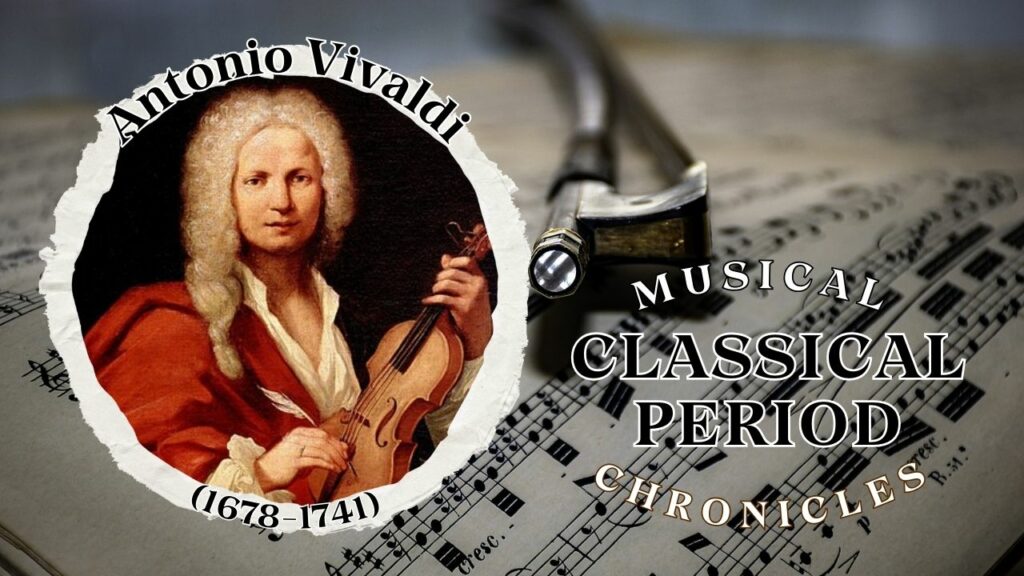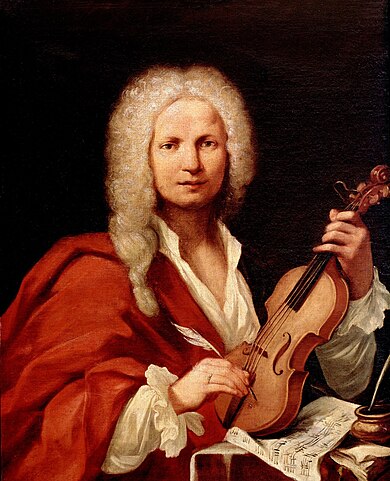
Antonio Vivaldi (1678-1741)
Financial Discord: The Strains of a Virtuoso
Immersed in the Baroque splendor of 17th-century Venice, Antonio Vivaldi, the virtuoso violinist, stood at the intersection of art and adversity. Born into a world enraptured by musical tapestries, his compositions danced through the canals and alleyways, yet behind the melodies, a discordant note echoed – the strains of financial hardship.
Vivaldi, a maestro of the violin, faced the perennial struggle of artists throughout history: the precarious nature of his income. The grandeur of his compositions, celebrated today, concealed the harsh reality of a virtuoso often teetering on the brink of destitution. The Baroque era, with its opulence, masked the economic disparities that even a musical luminary like Vivaldi couldn’t escape.
As the sonorous notes of Vivaldi’s violin resonated in the Venetian air, so did the jingling coins in his pocket determine the rhythm of his life. The intricacies of patronage, while essential for artistic survival, bound Vivaldi to a delicate dance of dependence. The financial whims of patrons dictated not only his livelihood but also the scope of his creative endeavors.
Artistic Freedom vs. Patronage: Vivaldi’s Creative Dilemma

Vivaldi’s predicament mirrored the broader tension of the era – a clash between artistic autonomy and patronage demands. The artistic flourishing of the Baroque period found itself entangled in a delicate web where creative expression often bowed to the desires of benefactors. Vivaldi, the red-haired virtuoso known as the “Red Priest,” navigated this intricate dance, seeking to compose symphonies that resonated with both his artistic vision and the preferences of patrons.
The halls of Venetian palazzos and theaters bore witness to this complex negotiation. Patrons, with their discerning tastes, often played a symphony of their own, directing the creative pursuits of the artists they supported. Vivaldi’s compositions, while masterful, were not immune to the influence of those who held the purse strings.
The financial discord found resonance in Vivaldi’s soul, prompting a creative dilemma that echoed through his compositions. The Red Priest yearned for artistic freedom, to compose not merely for the elite but for the soul of Venice itself. Yet, in the reality of his time, the symphony of creative independence often yielded to the demands of patrons who held the keys to both the palazzo and the purse.
This intricate interplay between financial constraints and artistic ambition set the stage for Vivaldi’s journey. His compositions, often celebrated for their emotive depth, carried the echoes of a virtuoso wrestling with the strings of autonomy and dependence. In the labyrinthine alleys of Venice, where every note seemed to narrate a different tale, Vivaldi composed not only for the present but as a hopeful overture for a future where the strains of financial discord would fade, and the melody of artistic freedom would crescendo.
But as the crescendo built, a looming interruption disrupted the harmony, throwing Vivaldi’s delicate balance into disarray. The geopolitical turmoil of 18th-century Europe, with its unpredictable cadence, would become the unforeseen interruption in the virtuoso’s symphony of life.
Vivaldi’s Symphony Unveiled: A Portrait of the Virtuoso’s Early Life
Within the labyrinthine canals and opulent piazzas of Venice, Antonio Vivaldi’s journey commenced. Born on March 4, 1678, in a city that echoed with the whispers of artistic passion, Vivaldi emerged as the son of Giovanni Battista Vivaldi, a humble violinist. Little did the city realize that within the walls of the Vivaldi household, a prodigious talent was unfolding.
From his earliest years, Vivaldi exhibited an unparalleled aptitude for the violin. His father, recognizing the burgeoning genius in his son, undertook the responsibility of honing young Antonio’s musical prowess. The echoing melodies of the violin, practiced diligently in the confines of their modest home, hinted at the future virtuoso that Vivaldi would become.
As the notes danced through the air, so did the financial strains that characterized Vivaldi’s early years. The Vivaldi family, not blessed with aristocratic wealth, navigated the ebb and flow of limited resources. It was primarily within these modest beginnings that Antonio Vivaldi developed an acute awareness of the intimate relationship between art and financial stability.
The young virtuoso’s educational journey took a distinctive turn when he entered the priesthood. Ordained as a Catholic priest in 1703, Vivaldi’s ecclesiastical calling intertwined with his musical aspirations. The Baroque period, with its fervor for expression and emotion, became the canvas on which Vivaldi painted his dual identity — the Red Priest and the virtuoso composer.
Venice, a city steeped in both religious fervor and artistic vibrancy, provided the backdrop for Vivaldi’s early endeavors. The vibrant cultural scene of the Baroque era enveloped the aspiring composer, influencing the rhythmic tapestry of his burgeoning compositions. Vivaldi, donned in the crimson robes of priesthood, found himself at the crossroads of two worlds — one dictated by divine devotion and the other by the resonating strings of his violin.
In the early 18th century, Vivaldi’s association with the Ospedale della Pietà, an orphanage for girls, became a defining chapter in his life. Appointed as the maestro di violino, Vivaldi’s role extended beyond ecclesiastical duties to nurturing the musical talents of the orphaned girls. The echoes of his violin reverberated within the stone walls of the Ospedale, creating a symphony that intertwined the destinies of the Red Priest and his protegeés.
It was within this educational tapestry that Vivaldi’s innovative spirit flourished. His groundbreaking concertos, capturing the essence of Venetian allure and Baroque exuberance, began to permeate the cultural milieu. The Red Priest’s compositions, driven by a desire to elevate the spirit and evoke emotions, laid the foundation for a musical legacy that would transcend the confines of time.
As Vivaldi’s reputation as a virtuoso and composer burgeoned, the financial nuances of his profession accompanied his rising star. The artist’s early years unfolded in the embrace of both artistic enlightenment and economic struggle, weaving a complex narrative that transcended mere musical notes. The Red Priest’s path, though laden with financial discord, became a testament to the symbiotic relationship between creativity and the fiscal realities of the Baroque era.
War of Strings: Vivaldi’s Symphony Paused
We interrupt this program for an important news update.
The year is 1709, and the War of the Spanish Succession has erupted, casting a somber shadow over the vibrant city of Venice. The grandeur of artistic expression momentarily yields to the cacophony of conflict, as Venetians grapple with the geopolitical upheaval.
Within the walls of the Ospedale della Pietà, where Vivaldi’s compositions had become the heartbeat of musical education, an unforeseen interruption unfolded. The war, with its demands on resources and attention, forced the Ospedale to redirect its focus from cultural endeavors to the pressing needs of wartime exigencies.
As the Republic of Venice grappled with the implications of the conflict, Vivaldi’s artistic sanctuary transformed into a microcosm of the broader societal challenges. The orchestra, once an emblem of musical transcendence, now faced the stark reality of war’s encroachment. The vibrant strings that once resonated in harmony were momentarily silenced, and the Red Priest found himself caught inside the crossfire of geopolitical discord.
The financial strains, already a recurring theme in Vivaldi’s life, intensified against the backdrop of wartime turbulence. The Ospedale, grappling with the economic repercussions of conflict, diverted resources away from cultural pursuits. Vivaldi, much like his beloved city, felt the reverberations of the war — a war that threatened not only the stability of nations but also the artistic sanctuaries that flourished regardless of the tumult.
In this unexpected interruption, the artist and his symphony became casualties of a larger narrative. The once-uninterrupted cadence of Vivaldi’s compositions now echoed the dissonance of a city entangled in the throes of war. As Venetians grappled with the ramifications of conflict, the Red Priest found himself navigating not only the intricacies of artistic expression but also the harsh realities of a world plunged into war.
We now return to our regular programming.
A Resilient Crescendo: Vivaldi’s Symphony Resumes
As the echoes of war reverberated through the canals of Venice, Antonio Vivaldi, undeterred by the tempest of geopolitical unrest, sought refuge in the enduring power of music. The interruption, though imposing, proved to be but a brief pause in the maestro’s symphony.
In the wake of the war, Vivaldi’s indomitable spirit refused to be subdued. The Ospedale della Pietà, despite weathering the storm of conflict, emerged as a sanctuary determined to revive its cultural legacy. The once-muted strings now tuned with newfound vigor, as the orchestra, much like the city itself, embarked on a journey of restoration.
Financial tribulations, an ever-present companion in Vivaldi’s life, began to relent as post-war reconstruction breathed life back into Venice. The artist, driven by an unwavering commitment to his craft, found solace in composing symphonies that mirrored the resilience of a city rebuilding itself from the ruins of conflict.
The interruption, marked by the shadows of war, gave way to a triumphant return to artistic expression. Vivaldi’s compositions, infused with the collective spirit of Venetians, soared once more through the hallowed halls of the Ospedale. The red vestments of the Red Priest, a symbol of both passion and perseverance, became synonymous with the city’s resolve to reclaim its cultural glory.
Amidst the echoes of rejuvenated strings, Antonio Vivaldi stood as a testament to the enduring power of art in the face of adversity. The interruption, however disruptive, became a chapter in the maestro’s life that underscored the resilience of both a musician and a city determined to harmonize once more.
Harmony Rediscovered: Vivaldi’s Legacy Resonates
As the final notes of Vivaldi’s symphony lingered in the air, a renewed sense of harmony enveloped the canals of Venice. The city, much like the Ospedale della Pietà, had weathered the storm of war and emerged with a reinvigorated cultural spirit. Antonio Vivaldi, the maestro of resilience, had orchestrated a triumphant return to musical prominence.
The interruption, with its somber chords, became a fleeting moment in the grand composition of Vivaldi’s life. Financial hardships, once a dissonant undertone, now seemed to harmonize with the city’s reconstruction efforts. The war’s aftermath, rather than stifling creativity, fueled a renaissance of artistic expression.
Vivaldi’s dedication to his craft, undeterred by the interruptions of war and financial struggles, echoed through the restored halls of the Ospedale. The red vestments of the Red Priest symbolized not only the passion within Vivaldi’s compositions but also the collective determination of a city to reclaim its cultural identity.
Venice, now adorned with the vibrant hues of resilience, became a living testament to the transformative power of art. Vivaldi’s legacy, a melody of perseverance, resonated far beyond the canals, inspiring future generations of musicians to navigate interruptions with unwavering commitment.
As the curtain fell on this chapter of Vivaldi’s life, the stage was set for a new movement in the grand symphony of musical history. The baton, momentarily stilled by interruption, now passed to a new composer waiting in the wings—George Frideric Handel. The next episode awaits, promising to continue the rich tapestry of musical narratives.
Return to the Classical Period Chronicles home page.
